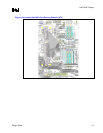
Intel
®
820E Chipset
R
Design Guide 33
Table 2. AGP 2× Data/Strobe Association
Data Associated Strobe
AD[15:0] and C/BE[1:0]# AD_STB0
AD[31:16] and C/BE[3:2]# AD_STB1
SBA[7:0] SB_STB
In this example, the lower address signals (AD[15:0]) are sampled on the rising and falling edges of
AD_STB0, while the upper address signals (AD[31:16]) are sampled on the rising and falling edges of
AD_STB1.
When routing strobes and their associated data lines, trace length mismatch is very important, in addition
to noise immunity. The primary benefit of source-synchronous strobing is that the data and the strobe
arrive simultaneously at the receiver. Thus, a strobe and its associated data signals have very critical
length mismatch requirements. With well matched trace lengths (as well as matched impedance), the
propagation delays for the strobe and the data will be very close. Hence, the strobe and the data arrive
simultaneously at the receiver. For some interfaces, the trace length mismatch requirement is less than
0.25 inch.
2.6. Differential Clocking/Strobing
AGP 2× timings are referenced at a particular level on the rising or falling strobe edge, while 4× timings
are referenced to the crossover point of the differential strobes. The crossover is targeted to be at
0.5 V
DDQ
.
2.7. Direct RDRAM* Interface
The Direct RDRAM channel is a multi-symbol interconnect. Because of the length of the interconnect
and the frequency of operation, this bus is designed to allow multiple command and data packets to be
present on a signal wire at any given instant. The driving device sends the next data out before the
previous data has left the bus.
Figure 12. RIMM Diagram
The nature of the multi-symbol interconnect forces many requirements on the bus design and topology.
First and foremost, a drastic reduction in reflected voltage levels is required. The interconnect
transmission lines must be terminated at their characteristic impedance, or the reflected voltage resulting
from an impedance mismatch will degrade the signal quality. These reflections will reduce noise and
timing margins and will reduce the maximum operating frequency of the bus. The reflections could
create data errors.


















